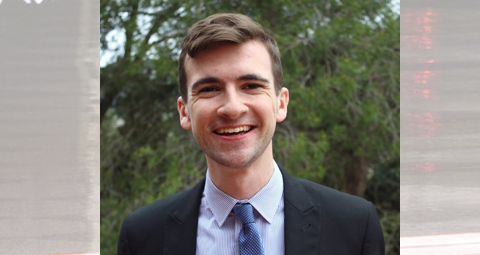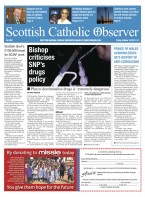July 26 | ![]() 0 COMMENTS
0 COMMENTS ![]() print
print

Scotland’s new breed of seminarian
The fashion at the Scots College is for skinny jeans, Limmy’s Show and Catholic apps — but our future priests are also adopting a fresh approach to evangelisation, writes first year seminarian Michael Kearns.
The highlight of a seminary year, ironically, comes after we leave Rome and return home for the summer, as a number of deacons are ordained to the priesthood.
It is the privilege of—to paraphrase from the ordination liturgy, in turn taken from St Paul’s letter to the Philippians—seeing God, who ‘begun this work’ in a man, ‘bring it to fulfilment.’
This year, the Scots College’s loss of our two most senior seminarians is very much Motherwell Diocese’s gain.
New generation
But I was struck by a slight demographic curiosity: one of our ordinees will probably be the last Scots College seminarian to be a member of ‘Generation X,’ the cultural grouping of people born from the early 1960s to the late 1970s.
This leaves the rest of us as—gasp—‘milennials,’ or even younger. It may shock you to know there are now Scottish men training for the priesthood born in the 21st century. So what is there to say of today’s seminarian, tomorrow’s priest?
Well, he is young, but could have a variety of backgrounds. The Scots College community includes former lawyers, engineers, sailors, tour guides, radio DJs, IT technicians, care home workers and supermarket shelf stackers. Gone are the days of most seminarians coming straight from school.
Catholic apps
Don’t worry if you see a seminarian using his phone in church. He isn’t scrolling through Twitter: he is probably just praying his Divine Office, a mobile phone app being more portable than a chunky breviary (although, admittedly, if the church is really nice, he may post a photo of it to Instagram later).
He knows more jokes from the BBC’s Limmy’s Show than from Morecambe and Wise. He gets his philosophy and theology books from Amazon, not the library. Chinos and Doc Martens are out, skinny jeans and New Balance trainers are in.
OK, I don’t speak for everyone on that last point—diversity of style is as important as diversity of background!
Post-Christian society
But we do all share one thing in common: today’s seminarians have grown up and chosen to enter priestly formation in a secularised, post-Christian society. The majority of our peers and friends are largely unaware of basic Christian teachings, practices or prayers.
The percentage of church attendance for our generation is in single figures. In a few decades’ time, Scotland will have a fraction of the number of priests, parishes and Massgoers that we do now. Modern society ignores God, and people seem to live their lives without Him.
Must this be, therefore, an era of doom and gloom? In a word, no. One thing I picked up from philosophy class this year is that Aristotle said young men have a tendency towards idealism and enthusiasm.
New evangelisation
The reality is, for those who have only ever known a world of secularism and marginalised Christianity, the mindset going forward isn’t poignant reminiscence of a bygone age, but an optimistic plan for evangelisation in the totally new landscape.
The task will not be managing decline, it will be going forth and reaching out to a culture which is desperately unaware but desperately hungry for the Good News of Jesus Christ.
And breaking news is exactly what the Church is supposed to be about. We’re at our best when we take the timeless and transcendent aspect of our Faith and bring it bang up to date. We don’t change it; we just have to make it relevant to those around us. It’s about moving from an ‘Acts 2’ evangelisation approach to an ‘Acts 17’ one.
St Peter
In the former, St Peter famously addressed the men of Judaea with an update to the story they already knew plenty about, with some new information about the beloved God of their fathers. With an Acts 2 approach, disciples who know God and love God get to know and love him even more. That preaching model has served generations of Scottish Catholics well.
But now we’re on Terra Nova. A new strategy is needed for new times, to reach people who may never have heard the Good News at all. In Acts 17, St Paul is in Athens. How can he reach a people so far from, and unfamiliar with, the truth? But Paul is savvy, edgy and culturally comfortable.
Altar to an unknown God
He takes what little they have already—an altar to an unknown god—and masterfully squeezes Jesus and salvation into terms relevant to his audience. St Patrick managed a similar tactic when he evangelised the Celts, as did 17th-century Jesuits in Japan or the Amazon.
So tomorrow’s Catholics—clergy and lay—are called not to be scared of, or hostile to, the new world emerging around us, but sure-footed, smart and comfortable engaging secular people in a secular society.
iPhone apps and New Balance trainers might just be 2020’s altar to an unknown god.
Discipleship and mission
As seminarians, for now we’ll continue to use the perennial wisdom of the Church to help us do the best we can to help others evangelise our country. Because even in a brand new cultural landscape, one thing remains utterly unchanged: discipleship and mission must go hand in hand. We aren’t disciples of Jesus if we don’t want to evangelise, and we can’t evangelise without knowing Jesus intimately.
That’s what priestly formation is all about. And that was exciting in the past. It’s exciting now. I think it’ll be exciting for years to come.
Michael Kearns is a first year seminarian at the Scots College, Rome.










